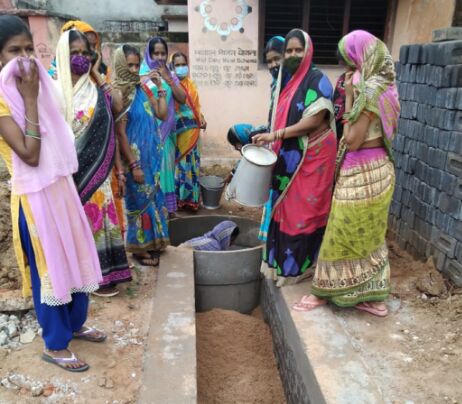Holding the rain
As the emerging water crisis is staring us in our face, Odisha’s rainwater harvesting model offers a simple but efficient solution

Urbanisation poses a threat to our natural environment: It leads to water scarcity, disasters, loss of biodiversity and more. Urbanisation, when carried out optimally and sustainably, can offer a solution for emerging urban problems.
The Housing and Urban Development (HUD) department, Government of Odisha has presented a great model. It involves 'catching the rain'.
The rapid growth of urban areas has adversely affected the natural recharge of groundwater aquifers. With this, surface water runoff has increased, thereby limiting its infiltration into the ground and causing water scarcity.
Rainwater harvesting can offer a great solution in such situations. Observing the irregularity in rainfall and increased flood frequency, many states have already adopted such steps to install a rainwater harvesting system in their cities to reduce surface water runoff.
Odisha leads by example. Delhi-based think tank Centre for Science and Environment is its knowledge partner. The state has developed 12,000 rainwater harvesting structures (RWHS) to facilitate water conservation and groundwater recharge in 2,035 wards of 114 urban local bodies.
This happened in less than three months' time, before the onset of the southwest monsoon.
Rainwater harvesting comprises collecting run-off from a structure or other impervious surface to store it for use. The process is used to conserve rainwater that runs off from rooftops, parks, roads and open grounds by collecting, storing, conveying and purifying it.
The state had selected sites to have these structures to address the state-wide campaign Catch the Rain: Where it Falls and When it Falls. This was completed under Mukhyamantri Karma Tatpara Abhiyan (MUKTA), an urban wage employment scheme for migrant workers.
Most Indian states in the last one decade have observed irregularity in rainfall patterns leading to a water crisis and a drought-like situation in some places while heavy rainfall led to floods in others.
Odisha is no exception: It is a water surplus state owing to its annual rainfall which varies from 1200 millimetres to 1800 mm, but its spatial distribution is uneven and erratic.
The state receives 76 per cent rainfall between mid-June and mid-September and the remaining throughout the year. Considering the uneven rainfall pattern, the only way to use the surplus rains received is by storing it.
The state government wanted to develop a mechanism that would be cost-effective, need a simple technology to operate and would require the least maintenance. The rainwater harvesting system type they developed was pit and burrow that cost Rs 35,000 per unit, involved no complex technologies and required less maintenance. It was completed in 7-10 days.
The Odisha government aims to conserve both rooftop runoff from schools, hospitals, community halls and other government and private-aided institutions as well as stormwater runoff from parks, playgrounds, open space, vacant lands and roads.
The spacing and number of recharge pits will be based on the porosity and permeability of the soil below 1.8 metres, annual average rainfall, intensity and duration of rainfall in that particular region. For average conditions, one recharge pit of 1.2 metres diameter and 1.8 m depth with 15 m leading channel is adequate for 250 sq m of the catchment area.
The recharge mechanism is also simple. Partial recharge of rainwater from the catchment happens through the loading channel. Surplus rainwater received from the loading channel and stormwater from the area surrounding the pit is recharged through filled media.
The sand layer acts as conventional surface water filter media. To support it, broken granite chips are provided underneath the sand layer. The sand layer filters out and retains the suspended solids thereby providing a base for the grey / black blanket formed over the sand due to the filtering of clay, silt and colloidal particles.
The filter media in the leading channel and recharge pits act like a porous membrane that allows the partially filtered rainwater to reach the soil media interface. The underneath soil layer acts as a natural filter, which facilitates the micro-filtration of rainwater before it reaches the groundwater table.
Over a period, the top layer turns grey or black which reduces the recharge efficiency. So, the top layered sand can be replaced periodically with new sand layers. The removed layer is rich in organic nutrients that can be utilised for filling the plantation sites in the park and open space area.
The Odisha government recommended mandatory construction of 5 RWHS/ward in a notified area council; 10 RWHS/ward in a municipality and 20 RWHS/ward in a municipal corporation of the 114 urban local bodies. Daspalla, one of the NAC in Odisha, has completed 80 RWH structures with 138 pits in 16 wards of ULBs.
According to Sasmita Pradhan, programme coordinator of MUKTA (a scheme to decrease the unemployment rate in the state), in Daspalla, 40 self-help groups and 2,898 people have been employed for this initiative as one pit required three people.
To strengthen transparency and accountability, the HUD, Odisha, has made it mandatory for the sites to be geo-tagged. It also directed district collectors to monitor the progress accordingly.
Rainwater harvesting is a go-to solution for the emerging water crisis. The anthropogenic activities have played a major role in furthering the climate crisis leading to overconsumption of underground water and depletion of the groundwater table.
Aquifers, which were used as a primary source of fresh water in several places, are not recharged efficiently, which leads to a decrease in the groundwater level. DTE
Views expressed are personal



